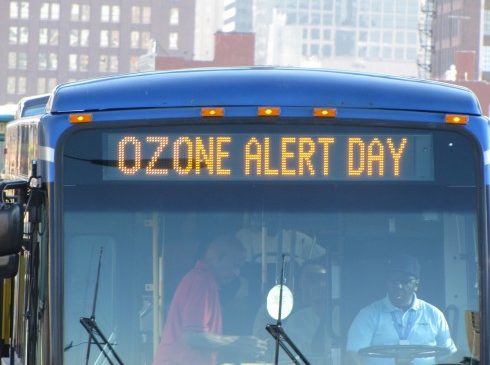Austin risking federal sanctions over ozone levels
Friday, September 22, 2017 by
Jack Craver Despite a rapidly rising population, Austin’s air is significantly less polluted than it was 20 years ago.
In a presentation to the Electric Utility Commission on Monday, Andrew Hoekzema, director of regional services at the Capital Area Council of Governments, said that Austin is the only major U.S. city that is meeting national standards in emissions for all six federally controlled pollutants.
Tighter vehicle emissions standards for cars and power plants have accounted for most of the reduction, said Hoekzema.
On five of the six pollutants, Austin’s levels are far below the maximum set by the Environmental Protection Agency.
However, things are a little too close for comfort when it comes to ozone, or trioxygen, high levels of which are linked to a number of respiratory and cardiovascular problems, most commonly asthma and bronchitis.
Even though Austin’s ozone levels have dropped dramatically over the past two decades, its current level is just barely meeting the federal air quality standards put in place in 2015, which sets 70 parts per billion as the maximum. The city’s level was measured at 66 in 2016 but it rose to 69 in 2017. An increase in emissions or a change in the weather could put the city at risk of being designated “non-attainment” next year.
“With our traffic problems I wouldn’t be shocked if we bumped over,” said Commissioner Erica Zell.
The 2015 rule has not been enforced yet. While the Trump administration initially signaled plans to delay implementation of the rule, it backed off in the face of a lawsuit from environmental groups.
The way the process works, the governors of each state make recommendations based on the states’ own monitoring data about which areas should receive non-attainment status. The first designations based on the 2015 rule are expected on Oct. 1, said Hoekzema, adding that it’s likely that El Paso and Bexar counties will be classified as non-attainment.
The consequence of non-attainment can be significant economic restrictions, including on private industrial development and public sector transportation projects.
In a 2015 study, CAPCOG estimated that non-attainment could cost the Central Texas economy anywhere from $24 to $41 billion between 2018 and 2046, or $900 million to $1.4 billion a year.
One of the most obvious ways to reduce ozone emissions would be to close the Decker Creek Power Station as soon as possible, suggested Hoekzema.
As part of a long-term energy plan adopted by City Council last month, Austin Energy has agreed to retire part of the power plant after the summer of 2020 and to close the second part a year later.
In recent years, the utility has reduced its reliance on Decker, and mostly powers it up during the hottest weeks of the summer to accommodate the high demand for air conditioning. Unfortunately, noted Hoekzema, the days when the utility kicks Decker into gear are most likely to be the most conducive to high levels of ozone. Hot temperatures, low humidity and big temperature swings contribute to ozone.
In an interview with the Austin Monitor, Hoekzema described emissions from Decker as the “lowest-hanging fruit” in the city’s efforts to reduce ozone levels.
Some members of the Electric Utility Commission wondered whether an administration directed by a president who has promised greater coal production and has called climate change a “hoax” would really be up to enforcing air quality standards set by the Obama administration.
Pointing out the administration’s earlier surrender after it proposed a delay of the rule, Hoekzema said he expected the rule to survive and be enforced.
“It takes a lot of effort to go back on a standard,” he said.
Chair Karen Hadden said that the presentation underscored the importance of the recent plan adopted by Council that aims to reduce greenhouse emissions. That plan was largely the result of a working group made up of members of the Electric Utility Commission, the Resource Management Commission and stakeholders from business, the environmental community and advocates for low-income ratepayers.
Photo courtesy of kcata.org.
The Austin Monitor’s work is made possible by donations from the community. Though our reporting covers donors from time to time, we are careful to keep business and editorial efforts separate while maintaining transparency. A complete list of donors is available here, and our code of ethics is explained here.
You're a community leader
And we’re honored you look to us for serious, in-depth news. You know a strong community needs local and dedicated watchdog reporting. We’re here for you and that won’t change. Now will you take the powerful next step and support our nonprofit news organization?











